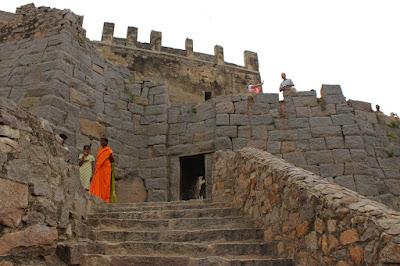...continued from Golconda fort, part-1.
On the left of this staircase is the dungeon where a civil servant Ramadasa was imprisoned for 12 years on the charges of embezzling funds. These steps lead up to Ambarkhana the granary.
To the left of Amabarkhana is a tower with clear views of spaces on either sides, a vantage point.
Builders have utilized the natural formations to the fort's advantage. If I'm not mistaken, there's a canon on the bastion atop the rock formation. The turret has a commanding view of the northern and eastern parts of the fort and the areas beyond. The footpath zigzags leading to Sri Jagadamba Mahakali Mandir. This footpath is good for horses in dry weather.
The short flight of steps leads to Sri Jagadamba Mahakali Mandir. Never been inside the temple. I feel the deity is embossed on the boulder.There's another set of steps which leads to a doorway beyond which is the circumambulatory path around the temple, I think. The painting of Mahakali is a superb piece of artwork. On the opposite boulder is an equally large painting of Durgadevi. Don't know why I missed capturing a picture of Durgadevi. Both paintings are eye-catching. The artist(s) have created these artworks with lots of devotion.
The twin boulders of Sri Jagadamba Mahakali Mandir.
Adjacent to Devi Mandir is the penultimate structure, Darbar hall also called Baradari. This gateway might've been elegant during its heydays. Guards would've been posted here to restrict entry only to authorized people.
The Darbar hall is a two storied structure built on a high platform. Tourists were allowed into the building earlier. I remember seeing the interior during my first two visits. For some reason entry into the building has been barred now. It's a high ceiling building with massive columns and arches. However, the building is bereft of decor.
The side walls of Baradari. The halls has large openings in it's walls allowing free flow of air and light. Hyderabad weather is mostly dry, summer days can be brutal. Thick stone walls with high roof and open windows can provide relief from cruel dry heat. To beat heat, people would definitely need water, so there has to be a source of water up here.
While the buildings at Golconda were built by Kakatiyas, Bahamanis and Qutub Shahis, there's one artifact which is relatively recent- this cast iron bench. It's a perfect bench for warm weather conditions provided it's placed in shade. The bench features Nizam logo on the backrest. Similar benches can be seen at Chowmahalla Palace complex which is situated close to Charminar. I've not dedicated a post to the palace but the related post Cannons of Chowmahalla palace should be interesting.
View of the ruins below.. the palaces, mosques, stables, courtyards, armory, fortified walls and what not.
View of the northern path as we take the southern path.
This gateway is the beginning of the steep steps. One needs to be careful on rainy days.. one misstep could end up in a disaster.
The path has several stages connected by steep & narrow steps. Looking back at the Baradari and the massive rock-fomation.
Some sly guides here try to bring tourists this way up. The steep steps looks pretty daunting discouraging tourists and they abort the tour at the base itself.
Side view of the staircase. It looks like a bridge supported on massive columns. The looks of this structure reminds me of structures at Bhuvanagiri fort better known by it's corrupt name Bhongir fort.
Light & shadow play inside a short tunnel connecting two levels.
Now we are on the ground level, inside one of the massive structures of the palace-courtyard complex.
During my first visit I'd noticed water pipelines built into the walls. Actually I could spot several pipelines running parallel to each other. Also there has to be a drainage system to transport sewage. The pipeline network supplied water to palaces, stables and courtyards.
Looking up again towards the summit through a gap in the ruins.
Talking about water pipeline systems, Adil Shai capital the fortified city Bijapur, and Bahamani capital Bidar's fort had advanced water supply systems. While Bidar fort is a tourist monument, Bijapur city is well occupied i.e. people live among the ruins within the fort walls. Bijapur main source of water was Bhutnal lake, for that matter even to this day it remains so. Distance between the city and lake is 5 km, a pipeline connected the two, water was supplied to the moat surrounding the fort, a dozen palaces, even mosques and homes. The city had a system to drain away excess rainwater too. In the present day, ancient underground pipelines and drainage lines were meddled badly causing water shortages and flooding during a heavy downpour.
I'll continue this tour in the following post- Golconda fort, part-3.
.........































No comments:
Post a Comment